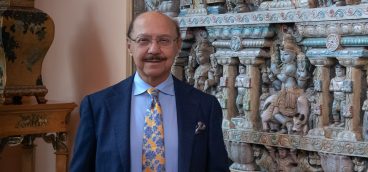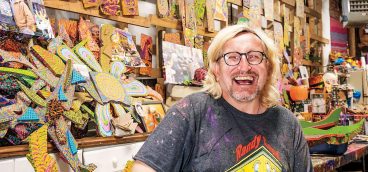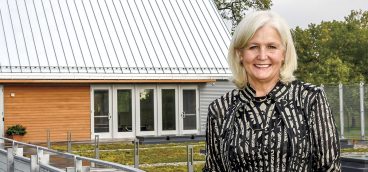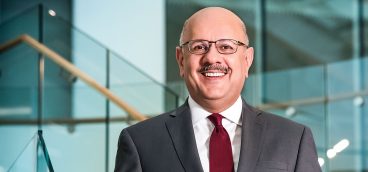What do I Know? Leslie Davis

My family is from New York, and my younger sister and I grew up in a suburban neighborhood on Long Island called “Five Towns,” which is about a 20-minute drive from Kennedy Airport. We were a typical 1970s family, except that my mother was an oral hygienist in a dentist’s office and loved her job. My dad was a merchandiser for Montgomery Ward, a large department store based out of Chicago.
My parents always talked about work in front of my sister and me. My father would talk about office politics. My mother talked about her patients in a very positive way (not disclosing their names, of course) and knew everything about them. I’m sure that many people went to that particular dentist just so they could chat with her. My sister and I used to wonder, “Why do you think all these people like seeing and talking with our mom?” Today, when I think about my role as a healthcare administrator, I believe that I’ve managed to combine the business experience of my dad with my mom’s need for human connection and caring. My parents both loved their work, and I think that shaped my early feelings about a career.
After graduating from high school, I wanted to move away from Long Island and experience other parts of the U.S. For financial reasons, my parents proposed a state university, and I could leave New York only if I found a state school that I preferred somewhere else. Well, my aunt and grandmother both lived in Florida, so I was able to get in-state residency through them, and enrolled at the University of South Florida (USF) in Tampa as a Spanish-English major.
Having grown up in New York, I knew that Spanish was an important second language. I remember, one day, being in a shoe store, looking at shoes in a long mirror, when a couple of teenagers, about my age, started making fun of me in Español. They thought I didn’t speak their language, but when I wheeled around and said, “Dícelo a tu mamá!” — which means “Say it to your mother” — they up and ran away. It’s a powerful feeling to be able to communicate in another language.
“When opportunity comes your way, take it.”
- UPMC, CEO (2021-present)
- UPMC Health Services Division, EVP & President (2021), SVP & COO (2014-2021)
- UPMC Magee-Womens Hospital, President (2004-2018)
- Tenet Healthcare, CEO (2002-2004), Graduate Hospital (2003-2004), COO Tenet Pennsylvania (2002-2003)
- University of Pennsylvania Health System, Chief Marketing & Planning Officer (1999-2002)
- Presbyterian Medical System Of Philadelphia, CEO (1997- 1999)
- Thomas Jefferson University Hospital,VP (1984-1997), Clinical Affiliations/Ambulatory Programs (1995-1997), various other positions (1984-1995)
- Mount Sinai Medical Center, Controller; Engineering Department (1981-1984)
- Tufts New England Medical Center, Administrative
Resident (1980-1981)
After earning a B.A. from USF, I taught English, ever so briefly, to middle-school Latin children, and loved them. I loved teaching, too, but ultimately didn’t like the monotony of doing the same thing, day after day. So, I knew that I’d have to pivot, career-wise. Trying to figure out which way to go, I started thinking about graduate school. I figured that I’d pick the two best schools for education in the country and hope to get into one of them. The two best schools, I learned, were Harvard and the University of Chicago. I was accepted at both, but chose Harvard, and decided just to “go for it,” and change my trajectory.
At Harvard, I met many interesting and motivated people, and learned as much as I could while serving simultaneously as an administrative resident at Tufts New England Medical Center. Then, one day, a colleague said to me, “You should think about healthcare, especially academic medicine. It’s the perfect balance between education and business. You’d be great at it.” I decided that a move from education into healthcare administration would indeed be a smooth segue. It felt right. So, I took courses at Harvard Business School and the Kennedy School, and ended up at Mount Sinai Medical Center, in New York, in the Information Management Section, which was, in those days, called “Medical Records.” Before long, I moved to the Engineering Department and worked with people who ran the various parts of the hospital.
My husband, Abe, however, was from Philadelphia and didn’t want to move to New York. He’s older than I am, and his law practice was already established. So, I said, “Fine. I’ll just move to Philly.” “Really?” he said. “Yeah,” I replied. “Why not?” So, I took a bus down to Times Square in New York and — just like that — found a job in Philly through the Philadelphia Inquirer. I even found us two houses to choose from. Then I went in on Amtrak, interviewed for the job at Thomas Jefferson University Hospital (which later became the Jefferson Health System), and was hired. My first role there was as the service line administrator for Behavioral Health. I said to my husband, “Well, now I have a job in Philadelphia. And there are two houses for you to consider. You have until Friday to make up your mind.” I really loved my job at Jefferson because it was within the clinical part of the hospital, not in medical records or engineering.
I stayed at Jefferson for 14 years, which is a long time at such an early point in one’s career. I always say, the time to think about moving on is when you can’t continue to grow, can no longer influence change, and are unhappy. Notice that I don’t mention “money,” because it’s never about money. Money is what people complain about when they’re not happy. But if you can stay somewhere and keep growing within that space, there’s no reason to feel like you have to leave. And I kept growing at Jefferson.
Frequently, my bosses at Jefferson would give me new things to do. “We’re going to merge with this hospital” or “We have a new CEO who needs help.” And so on. My job was really fun. And then, one day, a person called me and said, “There’s someone at Penn who wants to speak with you.” I thought, “They can’t really want to speak with me, can they? Maybe they just want to get some insider information about Jefferson.” Nevertheless, I met with the chief operating officer at Penn who was looking for a person to fill a job that would play a significant role in the organization’s operations.
At the time, Penn Medicine was the University of Pennsylvania Health System, and it had just acquired a hospital — Presbyterian Medical System of Philadelphia — that was similar to Shadyside, or Mercy Hospital, in Pittsburgh. It wasn’t the flagship institution, but it was an important enough hospital and someone had to run it, so I did, for a while. Before too long, I began working at the flagship and, a few years in, Penn’s chief marketing officer asked me to take on a new role, which included creating service lines across the region. Given my background in operations, I was an appealing candidate, and I moved into that job. Shortly thereafter, that same person became the chief administrative officer, and said to me, “I now want to make you the chief marketing officer. After all, I have to backfill myself.” I just looked at him and said, “But I don’t know anything about marketing.” He replied, “Don’t worry. I’ll help you.” Well, I never saw that man again after that, but I managed to figure things out. And it was a lot of fun working on strategy.
My husband and I have three kids and, at one point, all of them were under the age of 6. We lived in Philadelphia, and my parents, of course, lived in New York. But my mom and dad would unselfishly come every weekend to take care of the kids so that Abe and I could have an evening out. It was wonderful to have such help at an age in which my career was about to launch. It would have been very easy to put my professional life on hold until the kids were grown. I have many friends who did that because it was all too much — their jobs and their families. I was able to keep going because I’m married to a man who really values my career. He’s a lawyer and had an office in the neighborhood, so we were able to trade off responsibilities. If two people want to have careers, there has to be a give-and-take, and we had that.
I’ve been on a career track for nearly 40 years and have had almost every job there is to have within a healthcare organization. I’ve had progressive positions of authority yet, essentially, I had to work under one supervisor after another. So, I started thinking, “I want to be a supervisor, not the supervised.” One thing I always tell young professionals is, “When opportunity comes your way, take it.” That works well in corporations. People like it. And it has worked for me.
While at Penn, I decided that I wanted to be a hospital administrator again. The “big job” at the flagship opened up and, unfortunately, I got passed over for it. It happens. One of my problems was that I had become so identified with the creative side of things, with communications and marketing, and there was so much turnover that most of the new executives didn’t even realize that I had been recruited as an “ops” person. I kept reminding them, but no one believed me. That’s when I knew that I had to leave Penn if I wanted to get back into operations again. But, where to go? Tenet Healthcare is located in Philadelphia. It’s “for-profit” and owns seven hospitals in the region. I had never before worked for a for-profit institution, but figured that it was time to learn something new. I had gone the academic medicine route and it hadn’t been all that great. “Maybe the for-profits know something that we don’t know,” I thought.
Tenet hired me as the COO of the region. Then, one of the hospital CEO jobs opened up, and by then I really wanted to be a hospital president. Well, I got the job, did that for a couple of years and loved it. That’s what I wanted. Up until that point, it was the best job I’d ever had. Unfortunately, it was very hard working with the parent company, which was having all kinds of trouble at that time. Decisions were being made at the headquarters in Santa Barbara, not locally, and I was used to working within local communities. So, for the first time in my career, I began to work with an executive recruiter, who told me, “There’s a position open at a place called Magee.” I thought he was talking about Magee Rehab in Philadelphia, so I said, “I’m not interested in running a rehab hospital. I’ve been running a med-surg institution and I want to keep doing that,” to which the recruiter replied, “No, no. This is a women’s hospital in Pittsburgh that wants to be more than a women’s hospital. Talk to my clients in Pittsburgh and see what you think.” The next thing I knew, I was in Pittsburgh, at the Shadyside Inn. There, on the nightstand in my room, I ran across a beautiful glossy magazine. I flipped through it and learned of all the vibrancy in Pittsburgh. I took a walk on Walnut Street, called my husband and said, “It is very nice here.” And then I called a taxi to take me to Magee so I could “self-tour.”
The next day, I met with the folks who ran Magee. Then I came for a second visit, with Abe, and we both felt that it was time to make a change. He was actually willing to leave Philadelphia! “If this will work for you in your career, Leslie, I’ll make it work for me, too.” But we still had to “recruit” our three kids. So, we brought them to Pittsburgh and took them up to Mount Washington, and then drove on the bridge and through the tunnel into the city, which is a stunning entrance. We explained that summers in Pittsburgh are incredible (but the winters, not so much) and that Pittsburgh and Philadelphia aren’t too different. Soon, we bought a beautiful house, with a lovely block of neighbors, but I’m a bit ashamed to say that we were so paranoid at that point. When we first moved in, our neighbors threw a welcome party for us, and Abe and I kept saying to each other, “They must want something.” But they didn’t. They just wanted to be neighborly, meet our children and introduce them to theirs. Long story short, our kids thrived in Pittsburgh. All three of them, ultimately, have gone on to live in other cities, but they still have friends here. It’s nice to see that such connections can endure.
It’s no secret that when I get into what I’m doing, I really get into it, and Magee was a fabulous place to work. I loved what we did there. We transformed it from being a single-specialty hospital to a full-service one. But after more than a decade at the helm, I was again getting a little bored, so I started doing other “system” things, such as integrating Erie’s Hamot Hospital into UPMC when we acquired it. As always, I just raised my hand and said, “Sure, I’ll sleep in Erie a couple of nights a week. It’ll be fun.” It was the first time that I actually worked in a rural hospital. How surreal it seemed to drive my car to work, and pass a frozen lake on the way. And it was also interesting to learn that the way people approach healthcare in rural communities is very different from the way city folk do it. In time, we transformed Hamot into a viable UPMC hospital. Then, my boss, who was president of UPMC’s Health Services Division, left to become a CEO in Colorado, and Jeffrey Romoff, UPMC’s CEO, promoted me into the president’s position.
In my career, I’ve always tried to develop strong relationships with community members and with local business leaders. Synergy works for me. And when I think about diversity, I think about our management teams. I never assemble a team in which everyone is the same. Differing personalities, styles, ways of learning, gender, skin color and cultural background always make a team richer. People with different backgrounds and circumstances approach problems differently. The key is to make sure that the goals are aligned. How we get from “A” to “B” may be a little different, but as long as we get there, it’s fine with me. The same goes for leadership. Organizations require different kinds of leaders at different times in their evolution. And as a woman professional, I’m hoping that, going forward, there will be less stereotypical role-playing among male and female leaders.
I’m very excited about what’s ahead of us at UPMC as we continue to change and grow. Harvesting our innovation is very relevant to the care that we provide to patients in our service areas. We are able to take our discoveries and roll them out, in Pittsburgh and across the Commonwealth, and even to our international locations, working with the University of Pittsburgh and Carnegie Mellon University, and with our Technology Corridor. So, the future is bright. And I never lose sight of the fact that, at UPMC, we employ 92,000 people, and are a big part of the economic engine for this region.
Even before I was named CEO, I loved the job I was doing, which was running the operations of UPMC; all the clinical programs, the hospitals, the physician groups, and so on. This is the most interesting and most complex organization that I’ve ever been a part of. It is a combination of incredible clinical medicine, science, academics, enterprise, and innovation. And we are a growing insurance company, to boot. There is no end to what one can get involved with here. That’s what excites me most about UPMC.














